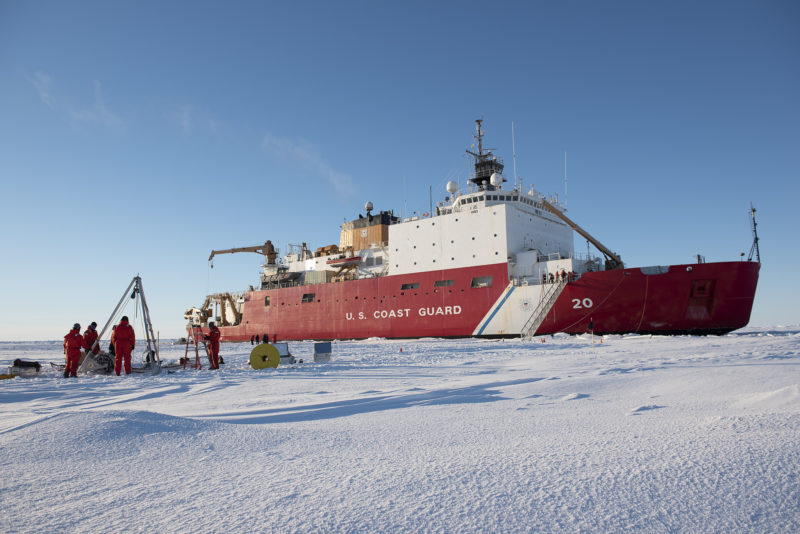The Coast Guard completed science missions with one of its remaining icebreakers while repairing the other this summer, as uncertainty continues over when the government will start building the first new polar ship in decades.
The crew of the 420’ medium icebreaker Healy completed their second mission of their Arctic West Summer 2018 deployment Oct. 18, returning to their Seattle homeport after studying stratified ocean dynamics in the Arctic (SODA) for the Office of Naval Research.
The project, led by Dr. Craig Lee of the Applied Physics Laboratory at the University of Washington, Seattle, seeks better understanding of how the Arctic environment affects different water layers in the Arctic Ocean, which in turn may help to better predict ice coverage in the region.
Summer seasonal ice coverage is changing with climate in the Arctic, making more areas of the high north potentially open to navigation. While Russia and other nations are expanding their capability to operate in the region – Russia has 41 icebreaking ships, by the U.S. military’s reckoning – only the medium icebreaker Healy, launched in 1997, and the 399’ heavy icebreaker Polar Star, now 42 years old, are available to the United States.

A team from the icebreaker Healy pulls a buoy across the Arctic ice Sept. 30, 2018, about 350 miles northeast of Barrow, Alaska. The buoy contains a series of sensors to measure wind speed and direction, air temperature, barometric pressure and other measurements to study stratified ocean dynamics. NyxoLyno Cangemi/U.S. Coast Guard photo.
The Polar Star returned to Seattle a day before the Healy, following a six-month maintenance layup at the Mare Island Dry Dock in Vallejo, Calif. During its annual deployment to Antarctica, the 13,000-ton heavy icebreaker breaks through ice up to 21’ thick clearing a path through frozen waters for supply ships to reach McMurdo Station, the Scott-Amundsen South Pole Station and other international bases, allowing them to operate year-round.
The last deployment was difficult with breakdowns, and fixes by the Polar Star crew prevented a major engineering casualty that could have disabled the ship – leaving the United States with just one working icebreaker. At Mare Island, the Polar Star got extensive overhauls to equipment, most notably in auxiliary systems, generator upgrades, and replacing propellers to prepare for its deployment for the 2019 Operation Deep Freeze, the U.S. military’s support of the National Science Foundation-managed U.S. Antarctic Program.
The Healy’s summer missions to the Arctic function as a floating base for scientists, and on the SODA mission 30 scientists and engineers accompanied the crew of 10 out of Dutch Harbor, Alaska, on Sept. 14. They deployed an array of automated scientific equipment to monitor conditions over the coming year and transmit data back to scientists at the Applied Physics Laboratory in Seattle.
“The Healy is the only vessel we operate as a country that can get us this far into the ice,” the laboratory’s Craig Lee said in a news release from the Coast Guard describing the mission. “If we wanted to come this far up north, we need to have an icebreaker. For the Arctic, the Healy is the only choice other than chartering a vessel from another country.”
The Healy crew deploys scientific equipment from the ship and oversees the safety of the visiting science team – tasks ranging from preventing man-overboard emergencies, to standing guard on polar bear watch while scientists are on the ice. During the SODA mission, the crew deployed navigation moorings, weather buoys, ice-tethered profilers to gather data in the water column, and autonomous underwater vehicles known as Seagliders.
“Our experience on this cruise has been exceptional,” said Lee. “We’ve received fantastic support – not just from a technical standpoint, but people were enthusiastic to get this done. You can tell the crew is focused on helping, rather than just doing their job. They make things efficient, get things done.”
The Office of Naval Research is supporting the study because the decreasing Arctic ice means nations will likely be competing on global shipping, tourism and exploiting natural resources in the region. Understanding the dynamics behind climate, weather, and ice conditions helps the Coast Guard and Navy to better prepare for operations in the high latitudes.
Coast Guard leaders took the occasion of the icebreakers’ return to Seattle to stress that building new Arctic ships must be a priority. There has been bipartisan support in Congress for appropriating enough money to build the first in a new class of heavy icebreakers.
But on in a July 25 letter to House Republican leaders, House Democrats criticized a 2019 homeland security funding bill for excluding the the $750 million icebreaker request approved earlier this year by the Senate. The bill would delay that project, “while wasting a staggering $4.9 billion on a border wall and increasing the Immigration and Customs Enforcement budget by $328 million,” wrote Rep. John Garamendi, D-Calif., the ranking Democratic member of the House Subcommittee on Coast Guard and Maritime Transportation, who composed the letter signed by seven fellow Democratic lawmakers.
The Coast Guard and its allies in Congress have stepped up the pressure themselves, promoting the future heavy icebreaker as a “national security” vessel. Coast Guard Commandant Adm. Karl Schultz, insists now is the time to start.
“As we move out on recapitalizing our polar icebreaker fleet, I am focused on a 6-3-1 approach,” said Adm. Karl Schultz, commandant of the U.S. Coast Guard. “We plan to build six icebreakers for the high-latitudes, at least three of which will be heavy, but we can't be in the Arctic the way America needs us unless we build one now.”




